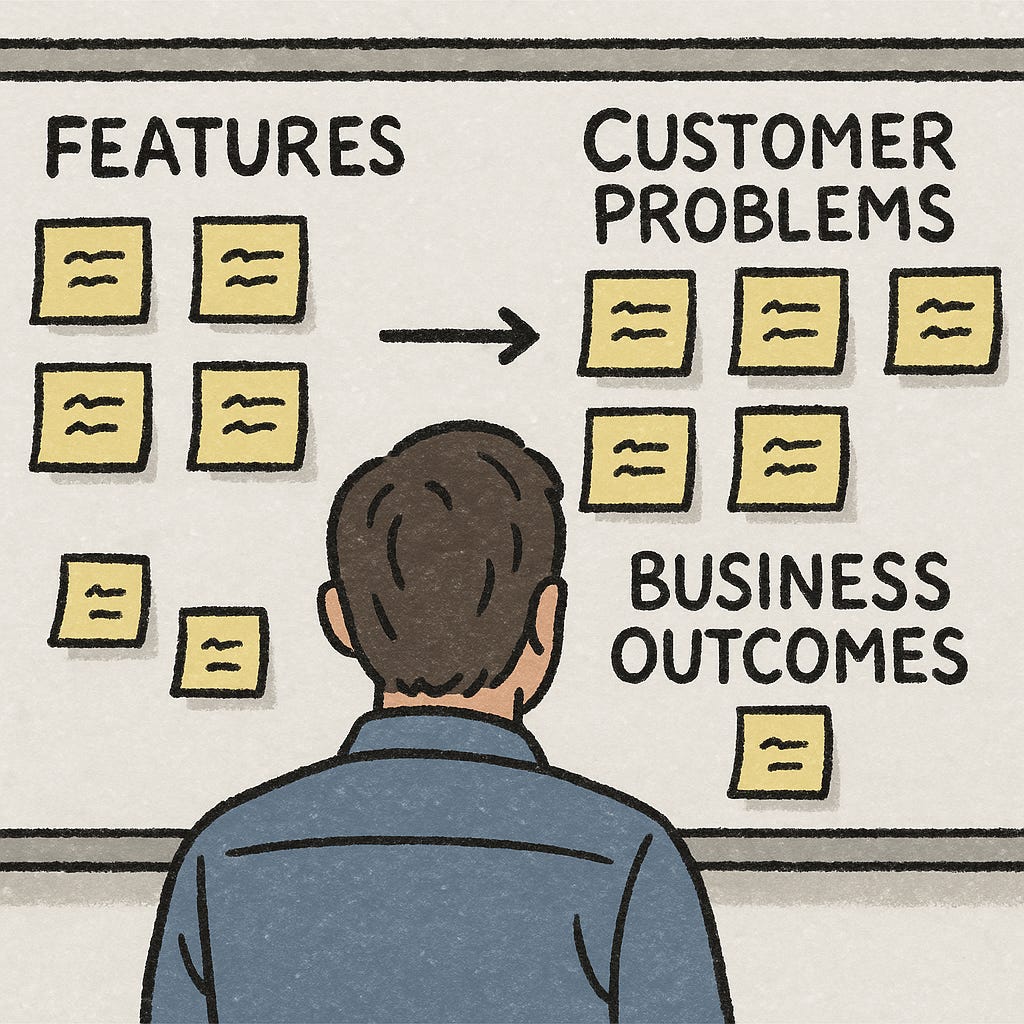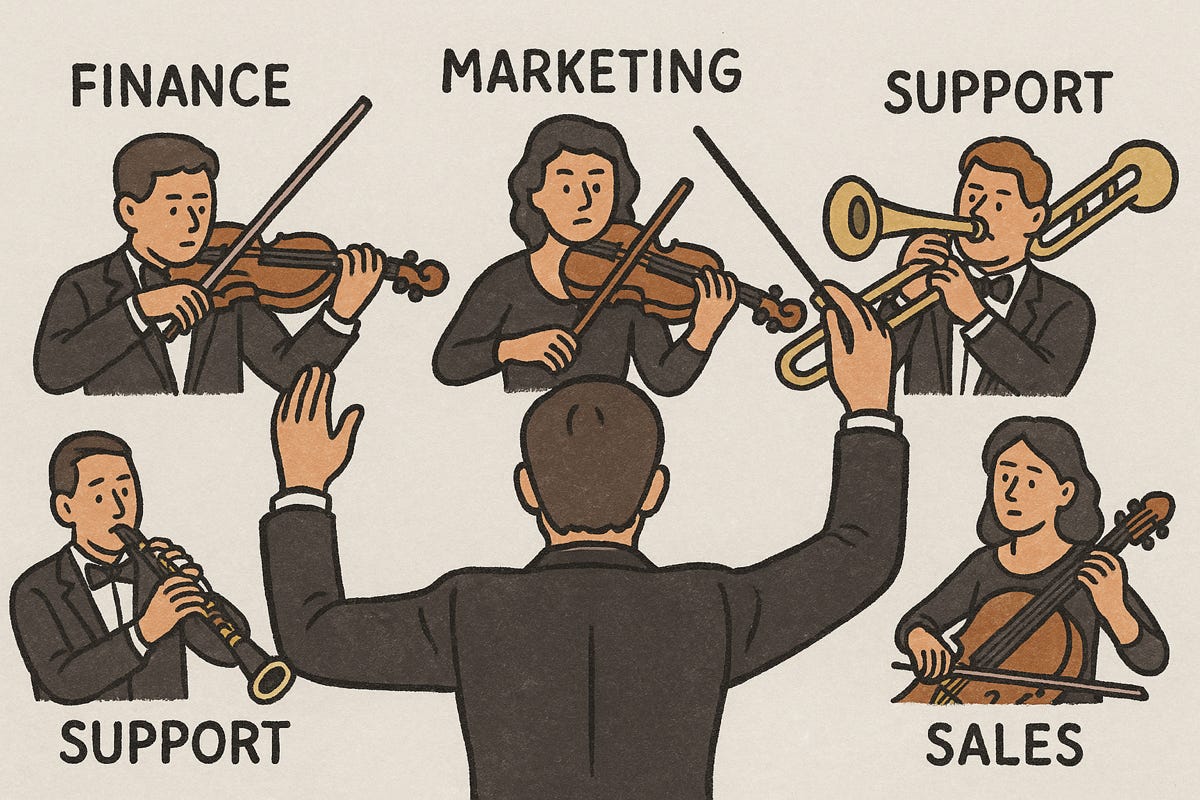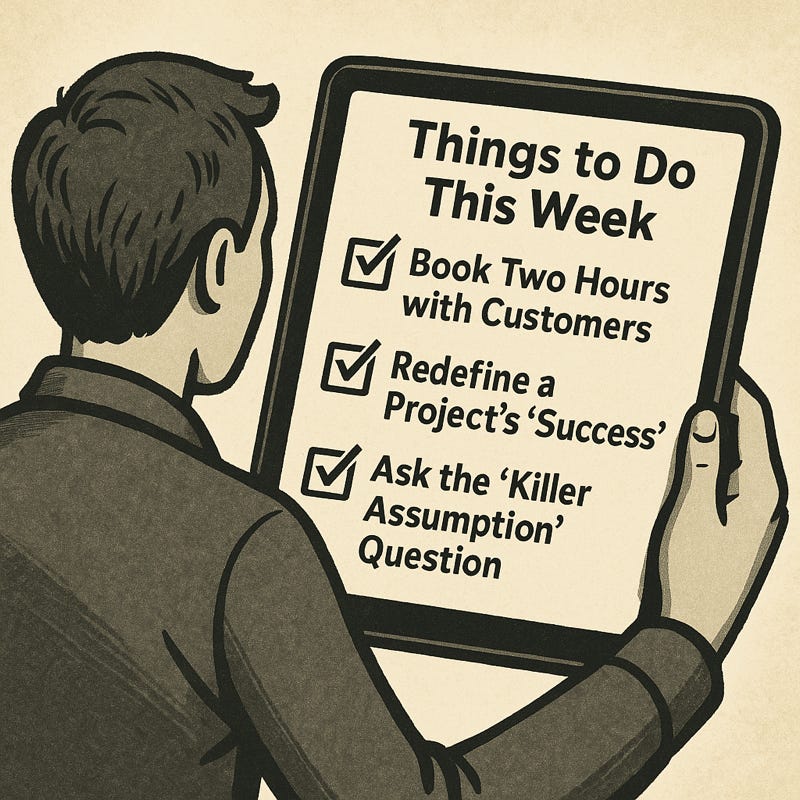The Project Manager’s Survival Guide to the AI Era
Why your value is no longer in managing scope, time, and budget—and how to become a Product Orchestrator instead.
From Project Juggler to Product Orchestrator: Your Survival Guide in the Age of Frictionless Tech
I was sitting in a quarterly review with a client, a FTSE 100 financial services firm. The Head of the PMO, let’s call him David, was presenting. His slides were immaculate. Gantt charts glowed green. Budgets were a hair under forecast. Timelines were met to the day. He finished his presentation, beaming, clearly expecting a round of applause for his team’s flawless execution.
Instead, the Chief Product Officer leaned forward and asked a simple, five-word question that sucked all the air out of the room: “So what? Did it help?”
David was floored. He started talking about deliverables, scope management, and resource allocation. But he couldn’t answer the question. He had successfully delivered a project that nobody, it turned out, actually cared about. He was the master of a ship that had sailed perfectly to the wrong island.
If this sounds familiar, you’re not alone. The ground is shaking beneath the feet of traditional project management, and many are too busy tracking dependencies to notice.
The Problem: Your Value Proposition is Evaporating
For decades, the project manager’s value was rooted in managing complexity and friction. The ‘iron triangle’ – scope, time, and budget – was your kingdom. Your mastery lay in wrangling developers, navigating technical hurdles, and ensuring the complex machinery of software delivery didn’t grind to a halt. You were the hero because you could make the damn thing get built.
But that friction is disappearing. The rise of what some are calling ‘vibe coding’ – using AI assistants and high-level frameworks to translate intent directly into functional code – means the technical act of building software is becoming radically easier. The bottleneck is no longer how to build; it’s what to build and why.
When any decent engineer can spin up a functional application in a weekend, your ability to manage a six-month waterfall plan becomes less of a superpower and more of a historical curiosity. The core challenge has shifted from execution risk to market risk. What if the real danger isn’t shipping late, but flawlessly shipping something that generates zero value?
This leaves many Project Managers and PMO officers in a precarious position. Your role, as you’ve always known it, is being automated and abstracted away. The core of your perceived value is becoming a commodity.
But here’s what makes this problem even more dangerous...
The Cost of Inaction: From Leader to Administrator
If you don’t adapt to this new reality, the future is bleak. You risk being relegated to the role of a highly-paid administrator, a glorified schedule-keeper who shuffles digital paperwork while the real strategic decisions happen in other rooms.
Think about it. A recent Gallup report highlighted that only 2.5% of companies successfully complete 100% of their projects. But the killer isn’t just failure to complete; it’s failure to impact. A 2020 study by the Standish Group found that nearly 20% of projects outright fail, and around 50% are ‘challenged’ – meaning they miss the mark on scope, time, or budget. But how many of the ‘successful’ ones, like David’s, were simply pointless?
When your entire focus is on inputs (time, budget) and outputs (features delivered), you become disconnected from outcomes (business results). You lead teams that become ‘feature factories’, churning out code that ticks boxes on a project plan but fails to move the needle on revenue, customer satisfaction, or market share. Your team might be busy, but are they effective?
In this world, you lose your seat at the strategic table. Your influence wanes. You spend your days chasing status updates instead of shaping strategy. The most talented people in your organisation will gravitate towards product-led teams where they can see the impact of their work, leaving you to manage the maintenance of legacy systems. Your career, once a promising upward trajectory, plateaus.
For you as a leader, this isn’t just a career risk for your PMs; it’s an organisational-level threat. A PMO stuck in the ‘juggler’ mindset becomes a black hole for investment, flawlessly executing projects that fail to deliver strategic value and bleed competitive advantage. You end up with a portfolio of perfectly delivered, entirely useless initiatives.
Fortunately, there’s a way out of this spiral...
The Solution: Evolve into the Product Orchestrator
This isn’t an obituary for project management; it’s a call for its evolution. The future belongs not to the Project Juggler but to the Product Orchestrator. This role leaves behind the obsession with deliverables and embraces the orchestration of value. It’s a fundamental shift from “Are we on track?” to “Are we building the right thing?”
Here’s the framework to make that transition:
Pillar 1: Master the ‘Why’, Not Just the ‘What’
The Product Orchestrator’s first job is to become the chief evangelist for the ‘why’. You must move from being a passive recipient of requirements to an active driver of outcome discovery.
How it works: Instead of starting with a 100-page business requirements document, you start with customer problems. You get out of the building. You spend at least 20% of your time talking to users, listening to sales calls, and digging into support tickets. You work with leadership to translate vague business goals like “increase engagement” into a concrete, measurable success metric, like “increase the average number of weekly user sessions from 2.1 to 3.5 by Q4.”
Client Example: I worked with a PMO lead at a major UK retailer. Her teams were consistently hitting delivery dates, but the e-commerce conversion rate was flat. We shifted her team’s focus for one quarter. They stopped measuring ‘features shipped’ and started measuring ‘add-to-basket rate’. This forced them to stop building what was on the roadmap and start running small experiments to see what actually influenced user behaviour. They shipped half the features but increased their primary metric by 15% in three months, which translated into an estimated £1.2 million in additional revenue for that product category over the next six months.
Pillar 2: Become the Conductor of the Value Stream
Think of your team and stakeholders as an orchestra. The old-school PM was like the first violinist, focused on their own section’s performance. The Product Orchestrator is the conductor. You don’t play an instrument; you ensure every section – engineering, design, marketing, legal, finance – is playing the same tune, at the right tempo, to create a harmonious and impactful piece of music.
How it works: This is strategic stakeholder engagement, not just status reporting. You’re not just sending a weekly email; you’re facilitating workshops, aligning disparate departments around a shared vision of customer value, and ensuring everyone understands how their piece of work contributes to the overall business outcome.
What this means for you: Your meetings change. Instead of asking, “What’s the status of your task?”, you ask, “What did we learn this week that changes our assumptions?” and “How can we help marketing prepare for the go-to-live of this feature to maximise its impact?”
Pillar 3: Leverage Frictionless Tech for Rapid Learning
Embrace the very tools that are making your old job obsolete. ‘Vibe coding’ and low-code platforms are not a threat; they are your new secret weapon. They allow you to shift the focus from managing one long, high-risk development cycle to orchestrating a series of short, low-cost learning loops.
How it works: Your job is to empower your team to build the smallest possible thing to test your biggest assumption. Can you validate a new feature idea with a clickable prototype made in Figma instead of a six-week code build? Can you test a new pricing model with a simple landing page and a spreadsheet on the back end? The Product Orchestrator’s mantra is: “What’s the cheapest, fastest way to learn if we’re on the right track?”
Client Example: A project manager in a logistics company I coach wanted to build a complex new routing algorithm. The project plan was 9 months. I challenged him to act as an orchestrator. He worked with a designer to prototype the algorithm's output and showed it to 10 customers. He learned that 8 of them didn’t care about the ‘optimal’ route; they just wanted a reliable two-hour delivery window. This insight, gained in 3 days, completely changed the project, saved an estimated £450,000 in development costs, and enabled a more valuable solution to reach market 6 months sooner.
Pillar 4: Coach the ‘What Next’ Conversation
This is the pinnacle of the Product Orchestrator role. Your most important function is to facilitate the continuous, evidence-based conversation about what the team should build next. You are the guardian of focus and prioritisation.
How it works: You arm yourself with frameworks. You don’t rely on the HiPPO (Highest Paid Person’s Opinion). You bring data. You use simple but powerful tools like RICE (Reach, Impact, Confidence, Effort) or Opportunity Solution Trees to structure the debate. You make the trade-offs visible to everyone.
What this means for you: You become a coach, not a taskmaster. You help your team and your stakeholders get better at making decisions. You create an environment where the best ideas, backed by the best evidence, win – regardless of where they come from.
Now that you understand the framework, let’s talk implementation...
Your First Steps as a Product Orchestrator
This is a significant shift, and it won’t happen overnight. But you can start tomorrow. Don’t ask for permission. Don’t wait for a new job title. Start acting like a Product Orchestrator now.
Here are three things you can do this week:
Book Two Hours with Customers: Get out of your project management tools and into the world of your users. Find two hours in your calendar and schedule calls with three real customers. Don’t ask them what features they want. Ask them about their problems, their goals, and their frustrations. Just listen.
Redefine a Project’s ‘Success’: Pick one of your current projects. Look at the official success criteria. Now, write down a new one based on a business outcome. For example, change “Launch the new checkout page by Nov 30th” to “Increase the checkout completion rate from 65% to 70% by the end of Q4.” Share this with your team and sponsor.
Ask the ‘Killer Assumption’ Question: In your next team meeting, put this question on a whiteboard: “What is the single biggest assumption we are making that, if proven wrong, would cause this entire effort to fail?” This one question starts to shift the focus from execution to validation.
Ready to get started?
Your Future is Calling
This evolution is not just a good idea; it’s a professional necessity.
The world has enough project jugglers. It is crying out for Product Orchestrators who can connect the work of talented teams to real, tangible business and customer value.
This is your opportunity to move from the periphery to the very heart of your organisation’s strategy.
Are you ready to stop managing projects and start orchestrating value?
Thanks for reading. If this article resonated with you, here are three ways to go deeper:
🎧 Listen to the full conversation: This article was inspired by insights from my Future of Work podcast.
Hear the complete discussion about temporal intelligence and real practitioner stories →
📬 Get weekly frameworks: Join 2,400+ transformation leaders who receive my newsletter every week. Each edition includes one actionable framework you can implement immediately to build agile leadership capabilities in the knowledge economy.
🤝 Work together: I help C-level executives and transformation teams navigate digital change and build varifocal leadership capabilities. Book a strategic conversation
New to the Future of Work insights? Start here: Use AI to Accelerate the Boring Bits and Get To The Good Stuff - it’s been shared by 500+ senior leaders and shows you how to [specific valuable outcome].
Already part of the community? Hit the ❤️ if this was valuable and share it with one colleague who’s struggling with temporal leadership challenges. The best insights come from peer discussions in the comments below.
What’s the biggest barrier you face in shifting from a ‘project’ to a ‘product’ mindset in your organisation? I read every comment and often turn your questions into future articles. Let me know what you’re wrestling with.
P.S. Next week I’m diving into “You Are the Product Owner of You: Taking Complete Control of Your Professional Growth”. Make sure you’re subscribed so you don’t miss it.*






